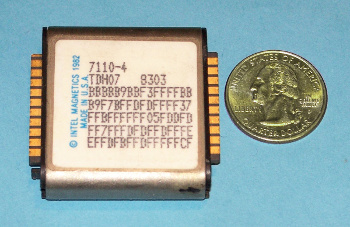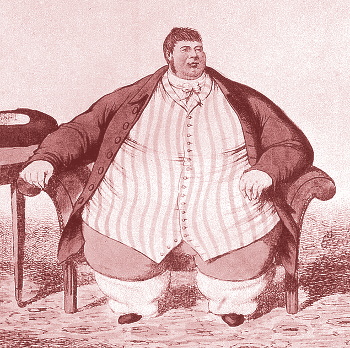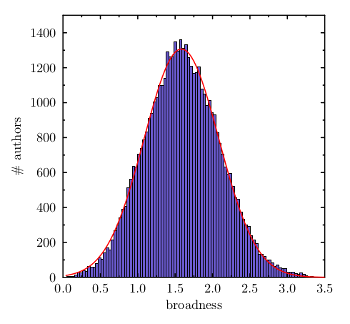Scientific Broadness
September 30, 2019
The best commentary about
scientists comes from scientists themselves.
American chemist,
Robert E. Swain (1875-1961) was head of the
Stanford University chemistry department from 1917-1940, and he was also a mayor of
Palo Alto, California and a founder of
SRI International. As reported on the notably
authoritative website,
quoteinvestigator.com, Swain explained the difference between a scientist and a
philosopher as follows:
"Some people regard the former as one who knows a great deal about a very little, and who keeps on knowing more and more about less and less until he knows everything about nothing. Then he is a scientist... Then there are the latter specimen, who knows a little about very much, and he continues to know less and less about more and more until he knows nothing about everything. Then he is a philosopher."[1]
There's obvious
criticism of either approach. Many scientists attempt to spend their entire
career researching the same narrow topic that earned them their
postgraduate degree. The
allure in this is great, since their
expertise is already established, and it's easy to continue from there. Today's
science, however, moves at a rapid pace, and it's likely that their previously important niche will fade from significance. I experienced this myself when one of my first scientific interests,
magnetic bubble materials, became a mere
footnote in the
history of
computer memory within just a
decade.

Intel Magnetics magnetic bubble memory module (c. 1982).
The US quarter dollar coin has a diameter of almost exactly one inch (24.26 millimeter, 0.955 inch).
(Wikimedia Commons image by the author.)
Fortunately, I had fallen sideways into magnetic bubble materials, having done previous work in the associated fields of the
rare earth elements and
magnetism, so this research was a
detour rather than a destination. Additionally, my withdrawal was aided by a developing interest in
optics that was inspired by my
laser-blasting
colleagues, and my
extracurricular interests in
computers and
electronics. It quickly became obvious to me that a broad background in science was essential for survival in a
corporate research
laboratory, where research projects have very short
lifespans. While a scientist might plan his
education around several disparate topics that appear to be useful in composite, the connections that an
interdisciplinary mind will make are mostly
random; and, it's the most random of these that often are the most useful.
Around the time that I started my involvement in magnetic bubbles,
science historian,
James Burke (b. 1936), presented his
television documentary series Connections on
PBS, followed by a series of similarly titled
articles in
Scientific American from 1996-2001. While the
history of science is usually presented in a
linear-logical fashion, Burke's
thesis is that the very useful things of today's world evolved from a connected progression of events with no logical plan. The series is interesting because of its confusion. A jumble of things is found to have led to some important
idea or
invention.
The idea of how broad
knowledge can lead to some interesting connections was explored by
Sabine Hossenfelder in an article entitled,
Automated Discovery, in her always interesting
Backreaction Blog.[2] She presents a 1986 paper that revealed a simple
syllogism that was buried in the
scientific literature. Dan Swanson of the
The University of Chicago saw one set of articles that showed how certain types of
fish oils aided
circulatory health, and another set that showed that improved circulatory health aided
patients with
Raynaud syndrome.[3] Swanson made the connection that fish oil would benefit Raynaud syndrome patients, and this was proved correct in a 1993
clinical trial.[2]

A scientist with broad knowledge; or, just a broad scientist?
In my experience, few scientists are obese, and there's a proven correlation between obesity and education level.
A recent paper on the topic concludes that higher body mass results in less education, rather than less education leading to higher body mass.
(Wikimedia Commons image, modified for artistic effect, Photo no. L0020234, library file ICV No 7381, an 1806 etching by C. Williams, from Wellcome Images by the Wellcome Trust.)
While such a connection seems obvious, the
evidence was buried in two disparate mounds of
scientific literature, so it wasn't noticed. That was in the
1980s, just at the start of
ubiquitous computing and the
Internet. Such
data mining is far easier today, and discovery of such connections can be
automated through use of
artificial intelligence agents. Hossenfelder cites as an example research by scientists from
Lawrence Berkeley National Laboratory (Berkeley, California) and the
University of California (Berkeley, California) in a recently published article in
Nature.[3]
The California research team looked at connections between published papers in my field of
materials science. While previous studies looked for connections using
keyword databases, the team used all the words in the paper
abstract, a technique that's much more
computationally intensive.[2-3] They've released their
Word2vec computer codes on
github.[4] Word2vec was developed at
Google, and I wrote about Word2vec research in 2017 on another materials topic in an
earlier article (Data Mining for Material Synthesis, February 19, 2018).
In the 2017 study, a team of
materials scientists and
computer scientists from the
Massachusetts Institute of Technology (MIT, Cambridge, Massachusetts), the
University of Massachusetts Amherst (Amherst, Massachusetts), and the
University of California Berkeley (Berkeley, California) data mined more than twelve thousand research papers to automatically deduce
recipes for
producing materials.[6-7] The team used data mining to find
hydrothermal synthesis recipes for
titania nanotubes. They found that it was possible to identify
paragraphs that contained recipes with 99%
accuracy.[7]
As an example that a full text indexing is superior to just indexing a paper's abstract, the California research team found that materials mentioned in the text body near the word
thermoelectric were not mentioned together in the abstract.[2] They demonstrated through use of
historical data that their computer system could recommend materials for functional applications several years before their actual discovery.[3] They predicted that fifty materials would be thermoelectric and found that these materials were about eight times more likely to be checked as thermoelectrics than randomly chosen unstudied materials.[2]
Tom Prince from
North Carolina State University, and Hossenfelder have posted an article on
arXiv that attempts to measure scientific broadness.[7] Not only is their article posted on arXiv, but their
analysis was on papers posted on arXiv. To examine a scientist's broadness, they removed all papers with more than 30
authors, since such huge collaborations were presumed to follow a different
probability distribution, and they also ignore authors with fewer than 20 papers, since so few publications makes broadness difficult to detect. The final sample contains 46,772 authors and 1,350,611 papers.[7]
Price and Hossenfelder developed a
model for scientific broadness of arXiv authors based on article posting across subject areas. This approach is
validated by the distribution of their broadness measure among the scientist sample (see figure). They found that the broadest interests were held by individuals in
plasma physics,
statistical mechanics, and the
mathematical areas of
numerical analysis,
probability, and
mathematical physics. The least broad (
narrow-minded?) were in
astrophysics of
galaxies, and
algebraic geometry.[7]

Probability distribution of broadness in the sample of arXiv authors.
The distribution is very close to a normal distribution, which is what would be expected if the definition of broadness was valid.
(Fig. 1 of ref. 8, via arXiv.[8])
More interesting is the broadness ranking of scientists by
country, as shown in the table. Scientists from the
United States and
Japan appear to lag behind those of countries such as
Israel,
China, and
The Netherlands, although the difference in broadness is not that large.[7]
Table: Mean broadness by country.
References:
- Knows Much About Little: That Is One Definition Given of Scientist By Chemist, 1928 April 7, The Ogden Standard-Examiner (Ogden, Utah), p 1, col. 4.
- Sabine Hossenfelder, Automated Discovery, Backreaction Blog, August 1, 2019.
- D.R. Swanson, "Fish oil, Raynaud's syndrome, and undiscovered public knowledge," Perspect. Biol. Med., vol. 30, no. 1 (Autumn, 1986), pp. 7-18.
- Vahe Tshitoyan,, John Dagdelen, Leigh Weston, Alexander Dunn, Ziqin Rong, Olga Kononova, Kristin A. Persson, Gerbrand Ceder, and Anubhav Jain, "Unsupervised word embeddings capture latent knowledge from materials science literature," Nature, v. 571, no.7763 (July 3, 2019), pp. 95–98.
- Supplementary Materials for Tshitoyan et al. "Unsupervised word embeddings capture latent knowledge from materials science literature", Nature (2019).
- Edward Kim, Kevin Huang, Adam Saunders, Andrew McCallum, Gerbrand Ceder, and Elsa Olivetti, "Materials Synthesis Insights from Scientific Literature via Text Extraction and Machine Learning," Chem. Mater. (Article ASAP, October 19, 2017), DOI: 10.1021/acs.chemmater.7b03500.
- Larry Hardesty, "Artificial intelligence aids materials fabrication," MIT Press Release, November 5, 2017.
- Tom Price and Sabine Hossenfelder, "Measuring Scientific Broadness," arXiv, August 3, 2019.
Linked Keywords: Scientist; American; chemist; Robert E. Swain (1875-1961); Stanford University; chemistry department; Palo Alto, California; SRI International; authoritative; quoteinvestigator.com; philosopher; criticism; career; research; researching; postgraduate education; postgraduate degree; allure; expert; expertise; science; bubble memory; magnetic bubble; materia; note (typography); footnote; history; computer memory; decade; Intel; magnetic bubble memory; modular design; module; US quarter dollar coin; diameter; inch; millimeter; Wikimedia Commons; rare earth element; magnetism; detour; optics; laser; colleague; extracurricular activity; computer; electronics; corporation; corporate; laboratory; longevity; lifespan; education; interdisciplinarity; interdisciplinary; mind; randomness; random; history of science; science historian; James Burke (b. 1936); television documentary series; Connections; Public Broadcasting Service; PBS; scientific literature; Scientific American; timeline; linear-logical; hypothesis; thesis; idea; invention; knowledge; Sabine Hossenfelder; backreaction.blogspot.com; Backreaction Blog; syllogism; The University of Chicago; fish oil; circulatory system; health; patient; Raynaud syndrome; clinical trial; obesity; obese; correlation; education level; body mass index; Wellcome Trust; evidence; 1980s; ubiquitous computing; Internet; data mining; automation; automated; artificial intelligence; Lawrence Berkeley National Laboratory (Berkeley, California); University of California (Berkeley, California); Nature (journal); materials science; index term; keyword; database; abstract (summary); computation; computationally; Word2vec; source code; computer code; github; Google; materials scientist; computer scientist; Massachusetts Institute of Technology (MIT, Cambridge, Massachusetts); University of Massachusetts Amherst (Amherst, Massachusetts); University of California Berkeley (Berkeley, California); recipe; chemical synthesis; material production; hydrothermal synthesis; titanium dioxide; titania; nanotube; paragraph; accuracy; thermoelectric effect; history; historical; data; Tom Prince; North Carolina State University; arXiv; analysis; author; probability distribution; conceptual model; statistical model validation; validated; plasma physics; statistical mechanics; mathematical; numerical analysis; probability; mathematical physics; narrow-minded; astrophysics; galaxy; galaxies; algebraic geometry; probability distribution; arXiv; author; normal distribution; country; United States; Japan; Israel; China; The Netherlands; Brazil; Austria; Switzerland; Germany; France; Canada; India; United Kingdom; Northern Ireland; Belgium; Sweden; Hungary; Spain; Italy; Australia; Iran; Poland; South Korea; Russian Federation.